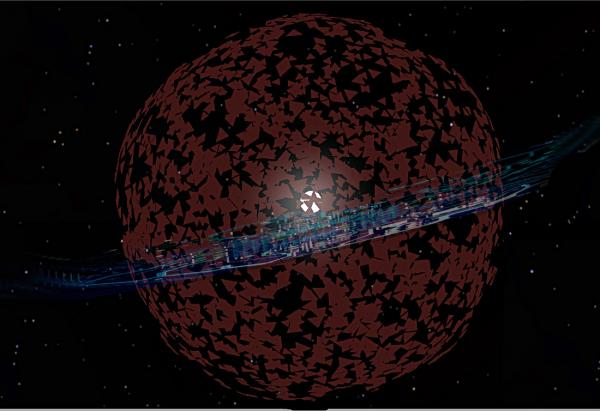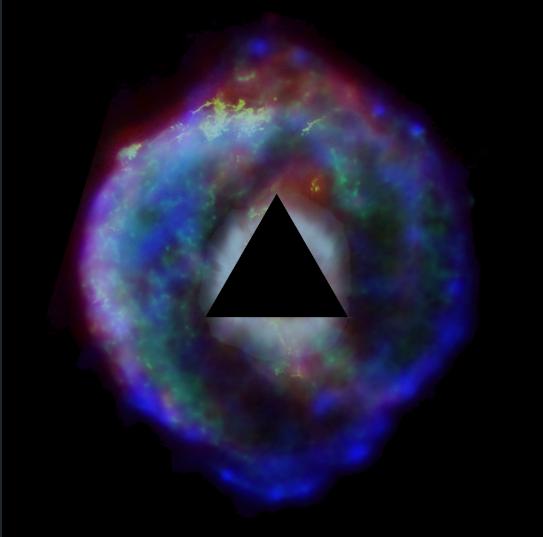BY LETTER
Medius
Galactography > Regions of Space > Middle Regions/Hinter-regions
Galactography > Sephirotic Empires > Mutual Progress Association
Galactography > Systems and Worlds > Systems & Worlds M - N
Galactography > Sephirotic Empires > Mutual Progress Association
Galactography > Systems and Worlds > Systems & Worlds M - N
Densely developed, highly industrial MPA system | |
 Image from Steve Bowers | |
| Medius Dyson Swarm consists of numerous triangular tiles in orbit around the star | |
Medius - Data Panel | |
| System: | Medius |
|---|---|
| Primary: | Erg (HIP 93229) |
| Stellar Type: | Originally F6 reduced to F9 |
| Region: | Mutual Progress Association core system, 245 ly from Sol, constellation Corona Australis |
| AI | AI Overseer: Triad AI's Ethos: Material progress |
| Polity | Name: United Habitats of Medius Symbol: Triangle superimposed over a starburst Affiliation: Mutual Progress Association Founded/Colonized: 2589 |
| Territory and Population | Population: 1.3 Trillion virtual residents 560 Billion embodied residents 1 billion+plus transients (tourists, travellers en-route, wanderers and itinerants) Habitats: 1268 Major biont habitats 188 Major Vec habitats 15 Major AI only habitats 12 million minor habitats of various clades |
| Economics, Local Infrastructure | Trade: Major exporter of antimatter and exotic matter, as well as data and processed information |
| Travel | Interstellar: Wormhole links to local Relay. Seven Beamrider Tramlines and Booster stations Eighteen Interstellar Spacetime Catapult for intra- and inter-system cargo transport Interplanetary: Intersystem beamrider network Automated laser cargo relay network Freedom of Movement : Travel is highly controlled to prevent accidents; ordinary sophonts are not allowed near the deep well mining zones, or near certain transap-only structures in the outer system. |
 Image from Chris0033547 | |
| Great Symbol of the United Habitats of Medius | |
The Medius system contained a large young F-class star along with several jovian worlds, terrestrial planets, planetoids and other debris. The system was perfect for industrialization. The industrialization process began by setting up a single wormhole link to the Djed system. Next the process of converting the planets and planetoids into a dyson swarm began. The dyson swarm would be made up of several triangular tiles in interlocking but independent orbits. A second layer of energy collectors was placed in interlocking and overlapping orbits covering the gaps of the first layer.
The triangular tiles are a special MPA design. They are covered in solar collectors that have a extremely high light to energy conversion rate approaching 98%. The energy gathered by each tile is used for three purposes. The first is the creation of an extremely powerful magnetic field that increases solar flare activity.
Ejected matter is funneled into the array where it is cooled; some is refined for use as normal matter for export, and is compressed into liquids or solids and shipped out to deep-well matter conversion sites around 30 AU from the star. There are currently nine deep well industrial zones in the Medius system. The tiles also use gamma-ray lasers to produce antimatter fuel, which is stored as solid metallic hydrogen and exported to a range of customers within and outside the system.
A significant fraction of the ejected matter is converted into exotic energy for the construction of wormholes and other space-time constructs such as void bubbles. The exotic energy is collected by automated, beam-propelled craft, which either take the negative matter to the weylforge at the north polar orbit of the star, the void-bubble factory at the south polar orbit, or to one of the wormhole links for export.
The second layer of energy collectors increase the efficiency of the dyson swarm by collecting waste heat and other energy that escapes between the gaps in the tiles.
Over time the five Jovian worlds of the Medius system were gradually converted into exotic energy for wormhole production. Medius has become one of the major MPA relay systems with over 100 wormholes from 1000 to 1300 meters in diameter, and a smaller number of up to 10 kilometers diameter. These wormholes are stacked geometrically around the star so that they maintain a minimum distance of 327 AU from each other, to maintain local flat space-time conditions.
There is a huge belt of habitats between the swarm and the deep well mining sites. There is also a large collection of habitats between the deep well mining sites and the various wormhole links. One of the most famous habitat clusters of the system are the Tar Vara habitats.
Travel within this system is facilitated by a local boostbeam network, using smart particles to accelerate and decelerate freight and passenger traffic between the local structures. Medius also acts as a boosting system for the Beamrider network and is host to a Deeper Covenant enclave. Seven separate beamrider tramroutes converge on the Medius system, and traffic between the tramways and the Nexus is brisk. Eighteen space-time catapults propel cargo both inside the system and to other stars at various fractions of the speed of light. Medius remains a bustling, melting-pot of cross-clade activity, with many empires having business interests and affiliates in the system.
Related Articles
Appears in Topics
Development Notes
Text by James Ramsey
Initially published on 17 March 2003.
Initially published on 17 March 2003.






